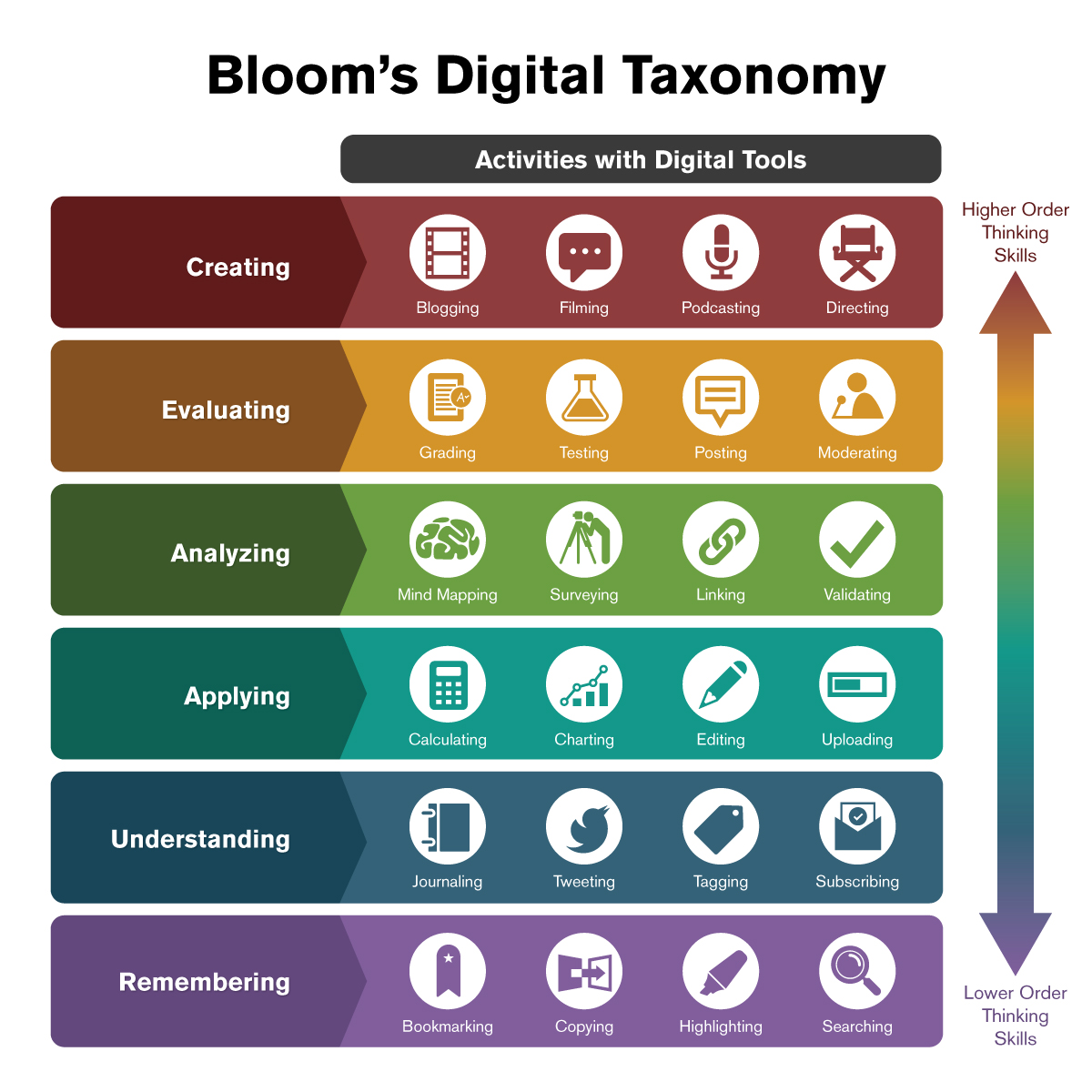Bloom’s taxonomy of educational objectives framework serves as the basis for classifying learning, teaching, and educational achievement in Canada (e.g., Ministry of Education, 2008). It consists of six hierarchical learning categories, and is often depicted in the form of a pyramid. The framework was initiated by Benjamin S. Bloom to facilitate the exchange of assessments among universities (Krathwohl, 2002). By doing so, Bloom hoped to curate a test bank to help minimize the labor of preparing annual comprehensive exams (Krathwohl, 2002). He believed that, beyond its function as a measurement tool, the taxonomy could be used as a common language for clear and honest communication across faculty, subjects, and grade levels (Krathwohl, 2002).
At the heart of Bloom’s taxonomy framework is the ability to create achievable learning goals that both teachers and learners easily understand in order to build a definitive plan to meet them. Using the categorization, educators can more effectively organize objectives and create lesson plans with appropriate content and instruction to lead students up the pyramid of learning.
Educators can also design various assessment tools and strategies to ensure each category is met in turn, and that each part of the course material is in line with the level’s objectives, whether it’s basic knowledge at the beginning of a course (e.g. basic recall), or applying that knowledge towards the middle of a school year (e.g. using the learned information in specific settings by solving problems).
For students, Bloom’s levels bridge the gap between what they know now, and what they need to learn to attain a higher level of knowledge. At the end of the learning process, the goal with Bloom’s taxonomy is that a student has honed a new skill, level of knowledge, and/or developed a different attitude towards the subject. And that teachers can effectively assess this learning on an ongoing basis, as the course moves through each stage of the framework.
We refer to the Bloom’s taxonomy framework to provide you with an organizational structure that will aid your understanding of the objectives classified in its categories and how you may consider and integrate new alternative forms of assessment. We hope that by doing so, we are helping you in your quest for a new and exciting assessment tool that best aligns with your educational goals. We encourage you to read the following overview of the categories prior to looking through the examples.
Each level of Bloom’s taxonomy should be addressed before moving on to the next. When course planning, bear in mind the implications—how quickly to introduce new concepts, when to reinforce them and how to test them. Something can’t be understood without first remembering it; can’t be applied without understanding it; must be analyzed before evaluating it, and an evaluation needs to have been conducted before making an accurate conclusion.
Integrating Technology with Bloom’s Taxonomy
Due to the increasing demand for online and hybrid delivery of courses, there is an added level of complexity when it comes to the challenge of creating authentic learning experiences in new formats. One important element to consider is students’ abilities and motivation, when integrating digital tools into assessment. An additional challenge with the online format is managing reduced real-time interaction with peers and instructors. As an instructor it is key to consider how to provide meaningful learning experiences for students using tools that are intrinsically motivating.
The revised digitally-focused Bloom’s Taxonomy aims: “To expand upon the skills associated with each level as technology becomes a more ingrained essential part of learning” (Bloom’s Digital Taxonomy, 2015). Your use of this adapted version and tools suggested should not focus “on the tools themselves, but rather on how the tools can act as vehicles for transforming student thinking at different levels” (Bloom’s Digital Taxonomy, 2015).
Summarized in the infographic below are the levels featured within Bloom’s Revised Digital Taxonomy accompanied by a scale of its relevance and examples of digital tools that connect with this taxonomy framework.

References
Heick, T. (2021, November 18). What is Bloom’s taxonomy? A definition for teachers. TeachThought. Retrieved December 3, 2021, from https://www.teachthought.com/learning/what-is-blooms-taxonomy/.
Persaud, C. (2021, February 25). Ultimate Guide to implementing bloom’s taxonomy in your course. Top Hat. Retrieved December 3, 2021, from https://tophat.com/blog/blooms-taxonomy/.

